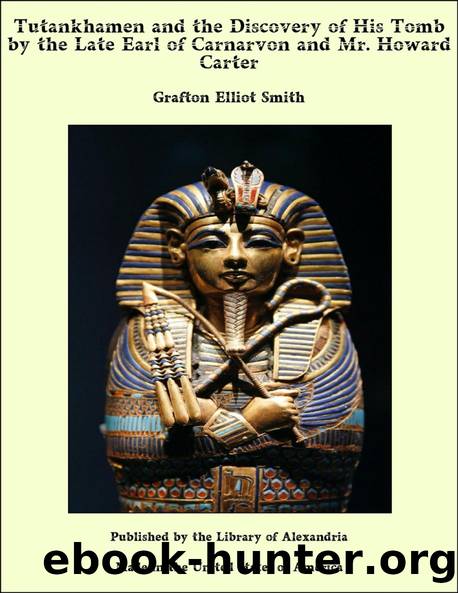Tutankhamen and the Discovery of His Tomb by the Late Earl of Carnarvon and Mr. Howard Carter by Grafton Elliot Smith

Author:Grafton Elliot Smith [Smith, Grafton Elliot]
Language: eng
Format: epub
Tags: Nonfiction, New Age, Religion & Spirituality, History, Fiction & Literature
ISBN: 9781465644213
Publisher: Library of Alexandria
Published: 2020-03-16T04:00:00+00:00
Fig. 12.âAn old photograph of the great cliffs behind Deir el Bahari, showing this temple as it was in 1881 before it was excavated. The royal mummies were hidden in a cleft in these cliffs.
Tomb-robbersâ Confessions
In the late Lord Amherstâs collection, which was recently sold in London, there was a judicial papyrus of the reign of Rameses IX (about 1125 b.c.), reporting the trial of eight âservants of the High Priest of Amen,â who were arraigned for plundering the tomb of King Sebekemsaf of the thirteenth dynasty. The written depositions of the prisoners set before the pharaoh by the vizier, the lieutenant, the reporter, and the mayor of Thebes were translated by Professor Percy Newberry in these terms: âWe opened the coffins and their wrappings, which were on them, and we found the noble mummy of the king. There were two swords and many amulets and necklaces of gold on his neck: his head was covered with gold. We tore off the gold that we found on the noble mummy of this god [i.e. the dead king who was identified with Osiris]. We found the royal wife also. We tore off all that we found from her mummy likewise, and we set fire to their wrappings. We took their furniture of gold, silver and copper vases, which we found with them.â The prisoners who made this confession were found guilty, and sentenced âto be placed in the prison of the temple of Amen,â to await âthe punishment that our lord the pharaoh shall decide.â There are several other famous papyri reporting trials of desecrators of the royal tombs. In the Abbott papyrus (in the British Museum) inspectors submit a report on the tombs that were said to have been plundered, but the only one that had actually been robbed was that referred to in the confession just quoted from the Amherst papyrus. The two Mayer papyri in the Liverpool Free Public Museums relate to plundering in the Valley of the Tombs of the Kings. One of these is of special interest at the present moment because it relates to the violation of the tomb of Rameses VI, which is immediately above that of Tutankhamen. The robbers were discovered as the result of quarrels among themselves about the division of the spoil. This was one of the most disgraceful incidents in the whole history of tomb-plundering. The robbers, in their haste to get at the gold and jewels upon the mummies, usually chopped through the bandages, and mutilated the mummy in the process. But when, in 1905, I removed the wrappings from the mummy of Rameses VI (which in ancient times had been removed to the tomb of Amenhotep II, where it was discovered by M. Loret in 1898), the body was found to be hacked to pieces. This was no mere accidental injury, but clearly intentional destruction of a malicious nature. It makes one realize the sort of vandalism Tutankhamenâs tomb so narrowly escaped.
Download
This site does not store any files on its server. We only index and link to content provided by other sites. Please contact the content providers to delete copyright contents if any and email us, we'll remove relevant links or contents immediately.
A FIGHTING MAN OF MARS by Edgar Rice Burroughs(329)
Prisoners of War in Britain 1756 to 1815 by Francis Abell(286)
Arsene Lupin vs. Herlock Sholmes by Maurice Leblanc(280)
Ireland In The New Century by Plunkett Horace Curzon Sir(279)
Hotwife Rescued--A Wife Sharing Multiple Partner Wife Watching Hotwife Romance Novel by Karly Violet(259)
Complete Works of John Buchan by John Buchan(254)
Lord Palmerston by Anthony Trollope(252)
The Frontiers of Language and Nationality in Europe by Leon Dominian(244)
The Amateur Diplomat by Hugh S. Eayrs & Thomas B. Costain(243)
Boris Karloffâs Favorite Horror Stories by Boris Karloff(239)
BY Anthony Trollope - The life of cicero . vol. 1 by 1881(236)
Scraps by Jane Austen(219)
The Life of Jesus Critically Examined by Dr. David Friedrich Strauss by George Eliot--Delphi Classics (Illustrated) by George Eliot(213)
Delphi Works of Sir Arthur Conan Doyle (Illustrated) by Sir Arthur Conan Doyle(201)
Siegfried and The Twilight of the Gods: The Ring of the Niblung II by Wagner Richard;(193)
Mr. Surprise Daddy: An Accidental Pregnancy Romance (Love, Accidentally) by Annabelle Love(184)
The Thousand and One Days by Miss (Julia) Pardoe(161)
A Journey through Persia, Armenia, and Asia Minor, to Constantinople, in the Years 1808 and 1809 by James Justinian Morier(160)
The First Book of Farming by C. L. (Charles Landon) Goodrich(158)
